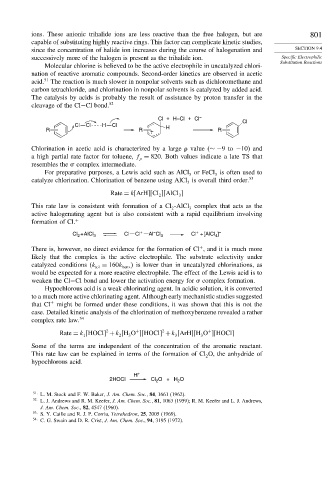Page 818 - Advanced Organic Chemistry Part A - Structure and Mechanisms, 5th ed (2007) - Carey _ Sundberg
P. 818
ions. These anionic trihalide ions are less reactive than the free halogen, but are 801
capable of substituting highly reactive rings. This factor can complicate kinetic studies,
since the concentration of halide ion increases during the course of halogenation and SECTION 9.4
successively more of the halogen is present as the trihalide ion. Specific Electrophilic
Substitution Reactions
Molecular chlorine is believed to be the active electrophile in uncatalyzed chlori-
nation of reactive aromatic compounds. Second-order kinetics are observed in acetic
51
acid. The reaction is much slower in nonpolar solvents such as dichloromethane and
carbon tetrachloride, and chlorination in nonpolar solvents is catalyzed by added acid.
The catalysis by acids is probably the result of assistance by proton transfer in the
cleavage of the Cl−Cl bond. 52
Cl + H–Cl + Cl – Cl
Cl Cl H Cl
R R + H R
Chlorination in acetic acid is characterized by a large value (∼−9to −10) and
a high partial rate factor for toluene, f = 820. Both values indicate a late TS that
p
resembles the complex intermediate.
For preparative purposes, a Lewis acid such as AlCl or FeCl is often used to
3
3
catalyze chlorination. Chlorination of benzene using AlCl is overall third order. 53
3
Rate = k ArH Cl AlCl
2
3
This rate law is consistent with formation of a Cl -AlCl complex that acts as the
3
2
active halogenating agent but is also consistent with a rapid equilibrium involving
formation of Cl. +
–
+
Cl +AlCl 3 Cl Cl + Al Cl 3 Cl +[AlCl ] –
2
4
There is, however, no direct evidence for the formation of Cl , and it is much more
+
likely that the complex is the active electrophile. The substrate selectivity under
catalyzed conditions (k = 160k is lower than in uncatalyzed chlorinations, as
tol benz
would be expected for a more reactive electrophile. The effect of the Lewis acid is to
weaken the Cl−Cl bond and lower the activation energy for complex formation.
Hypochlorous acid is a weak chlorinating agent. In acidic solution, it is converted
to a much more active chlorinating agent. Although early mechanistic studies suggested
+
that Cl might be formed under these conditions, it was shown that this is not the
case. Detailed kinetic analysis of the chlorination of methoxybenzene revealed a rather
complex rate law. 54
2
2
+
+
Rate = k HOCl +k H O HOCl +k ArH H O HOCl
1
3
3
2
3
Some of the terms are independent of the concentration of the aromatic reactant.
This rate law can be explained in terms of the formation of Cl O, the anhydride of
2
hypochlorous acid.
H +
2HOCl Cl O+H O
2
2
51
L. M. Stock and F. W. Baker, J. Am. Chem. Soc., 84, 1661 (1962).
52 L. J. Andrews and R. M. Keefer, J. Am. Chem. Soc., 81, 1063 (1959); R. M. Keefer and L. J. Andrews,
J. Am. Chem. Soc., 82, 4547 (1960).
53 S. Y. Caille and R. J. P. Corriu, Tetrahedron, 25, 2005 (1969).
54
C. G. Swain and D. R. Crist, J. Am. Chem. Soc., 94, 3195 (1972).

